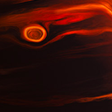 To date, despite the huge number of exoplanet discoveries, the formation and properties of giant planets remains a mystery. Giant exoplanets sculpt young exoplanetary systems, and might determine whether smaller Earth-like planets could be capable of harboring life. The observation and characterization of the properties of young exoplanets is crucial to help scientists to understand what giant exoplanets are made of, how they differ from Jupiter and Saturn, and how they formed.
To date, despite the huge number of exoplanet discoveries, the formation and properties of giant planets remains a mystery. Giant exoplanets sculpt young exoplanetary systems, and might determine whether smaller Earth-like planets could be capable of harboring life. The observation and characterization of the properties of young exoplanets is crucial to help scientists to understand what giant exoplanets are made of, how they differ from Jupiter and Saturn, and how they formed.
In 2014, ESO instruments revealed the image of a new planetary system made of a young giant circumbinary planet VHS1256b (3). This exotic “ Tatooine-like ” system provides an ideal laboratory to dissect the physical and chemical properties of an exoplanet but also potentially to trace its formation mechanism through its composition.

New observations with the James Webb Space Telescope obtained by an international team(1), in combination with VLT (2), provide the most detailed “digital fingerprint” (or spectrum) of an exoplanet ever obtained. This footprint reveals the presence of key molecules also identified on Jupiter. The unprecedented accuracy of the data gives the first robust constraint on the temperature of that exoplanet as well as a measurement of the ratio between the atoms of carbon and oxygen in the atmosphere of the object, which is believed to be set by the formation mechanism of the object. Astronomers have observed a direct signature of clouds of silicate dust in the atmosphere of an exoplanet for the first time. These dust clouds do not form in our Jovian planets which are colder and will help to solve a long-standing debate on the proposed physical mechanisms in the atmosphere of young exoplanets.
Both research papers on NIRSpec-MIRI/JWST and X-Shooter/VLT were led by two talented young scientists, Brittany Miles, a young Fellow at the University of Arizona, and Simon Petrus, a young Fellow at Valparaiso University in Chile. This work involves several French scientists from AIM, IPAG, LAM, LESIA, and Lagrange laboratories. Gael Chauvin, director of research at the J.-L. Lagrange Lab, participated in both studies, in particular with the development and the application of spectral analysis tools in connection with the models of exoplanetary atmosphere.
References
1. JWST/MIRI and NIRSpec Characterization paper (Miles et al. 2022)
2. X-SHOOTER Characterization paper (Petrus et al. 2023)
3. Discovery paper based on VISTA results (Gauza et al. 2015):
NASA Link & Credits :
https://webbtelescope.org/contents/preview-releases/2023/01GTCVT8CMM9FKPKNKBEN3SNKW.html
Claire Blome, Space Telescope Science Institute, Baltimore, Maryland
Christine Pulliam, Space Telescope Science Institute, Baltimore, Maryland
Contacts
- Simon Petrus, spetrus@npf.cl, +56 9 7882 9074, NPF/Valparaiso
- Mickaël Bonnefoy, mickael.bonnefoy@univ-grenoble-alpes.fr, 06 37 13 43 68, laboratoire IPAG (CNRS - Université Grenoble Alpes)
- Gael Chauvin, gael.chauvin@oca.eu, 06 45 51 82 09, laboratoire Lagrange (Université Côte d'Azur - Observatoire de la Côte d'Azur - CNRS)
- Pierre Baudoz, pierre.baudoz@obspm.fr, & Anthony Boccaletti, anthony.boccaletti@obspm.fr, laboratoire LESIA (l’Observatoire de Paris-PSL - CNRS - Sorbonne Université - Université Paris Cité).
- Elodie Choquet, elodie.choquet@lam.fr, 04 95 04 41 16, & Arthur Vigan, arthur.vigan@lam.fr, laboratoire LAM (CNRS - Aix-Marseille-Université - CNES)
- Pierre-Olivier Lagage, pierre-olivier.lagage@CEA.FR, CEA/AIM







